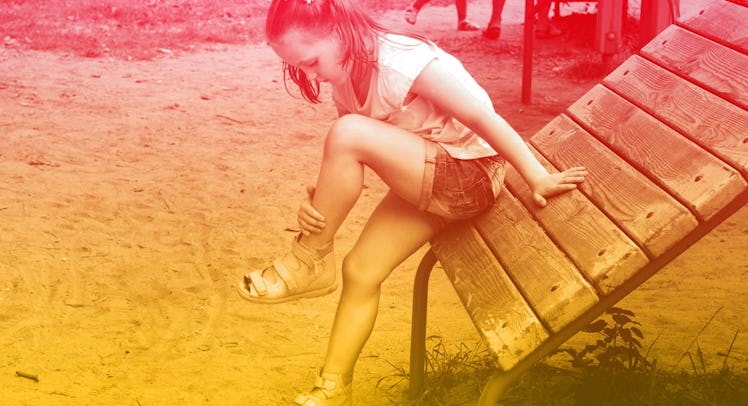My Kids Got Hurt On Playground Equipment. Who Can I Sue?
Depending on your jurisdiction, pretty much everyone could be legally liable, from the guy who laid the mulch to the teacher who was texting when your kid tumbled off the monkey bars.

Playground equipment causes roughly 200,000 injuries per year in the United States, and about 15 fatalities. Slides and swing seats are built to turn children into projectiles. Blacktop is unforgiving; crowded jungle gyms are essentially ruled by the laws of the jungle. This might unnerve some parents enough to make them wonder whether school outdoor playground equipment is worth the risk. But when a child does get hurt on school playground equipment, for instance, who is to blame? Can you sue the city? The school board? The manufacturer?
It depends. (And please start by taking a breath; no one likes the litigious person.) The specific laws surrounding playgrounds differ by state, and if your child is injured you should consult a local lawyer. But here’s a general rundown of how playground liability works in the United States:
Who Might Be To Blame?
Depending on your jurisdiction, pretty much everyone could be legally liable, from the guy who laid the mulch to the teacher who was texting when your kid tumbled off the monkey bars. The three most often liable parties are the owner of the playground (including the school district and the local government), the manufacturer of the equipment or the contractor who installed it, and individual employees responsible for watching your children (a nanny or a teacher).
When Can I Blame The Owner, Operator, Or Manufacturer?
The first step is to figure out who owns the playground. Most states grant immunity to public schools and local government entities unless you can demonstrate truly horrific negligence, so you’re frequently out of luck if your kid gets injured on government property. On the other hand, private playgrounds (at private schools or daycares, for instance) are not immune.
The second step is to establish whether the danger your child encountered was “foreseeable”. If so, you can often bring a lawsuit based on “premises liability theory”, which states that operators have a responsibility to prevent foreseeable injuries on the equipment that they own. Courts determine whether a playground injury was foreseeable by asking whether the child was the type of person the defendant expected to be on the property, the child was injured in a foreseeable way, and the defendant’s carelessness was the major cause of the child’s injury.
Manufacturers have more legal protection than owners and operators, and they are not liable for every foreseeable injury that can occur on their products. You’re unlikely to win a lawsuit against a manufacturer unless the company cut corners safety-wise, or produced defective equipment.
When Can I Blame Those Paid To Watch My Kids?
Generally speaking, you can only sue a caretaker for negligent supervision if the defendant agreed to supervise your child, the defendant did not properly monitor your child, and your child was injured as a direct result of the inattentiveness of the defendant. Which means it’s tricky to sue a teacher or nanny for a playground injury, especially when dealing with older children—it is rare that a 10-year-old is injured as a direct result of a caretaker’s inattentiveness.
Florida, however, is one state that has more lax requirements to prove negligence. Under Florida law, school employees have an affirmative duty to supervise students at school. If plaintiffs can establish that a teacher did not adequately supervise the students or otherwise failed to take precautions (poor lighting, lack of security cameras), they can win in court.
How Do I Keep My Kids Safe On Playgrounds?
The United States Consumer Product Safety Commission has a handbook on playground safety, and The National Program for Playground Safety has its own list of hazards. Here are a few to look out for—not just as a way of proving liability, but also to help keep your kids safe:
- Lack Of Guardrails: All raised platforms should be guardrails between 2 and 4 feet high
- Age-Inappropriate Activities: Preschoolers should not play on equipment higher than six feet. Elementary school kids shouldn’t play on anything higher than eight feet.
- Improper Protective Surfaces: The material beneath equipment should be surrounded by six feet of shock-absorbent material (shredded rubber, wood chips, mulch, sand)
- Protrusion Hazards: Bolts and other sharp objects and edges should be covered.
- Entrapment Hazards: No openings in playground equipment (including ladder rungs) should be between 3.5 and 9 inches, because that’s the sweet spot at which a child can fit his or her head through an opening, but not his or her body, and end up trapped.
- Insufficient Spacing: Equipment taller than 30 inches should be spaced at least 9 feet apart from similar equipment. Swings should be at least two feet from the base and 30 inches from the support structure. Each “use area” must be six feet apart.
This article was originally published on